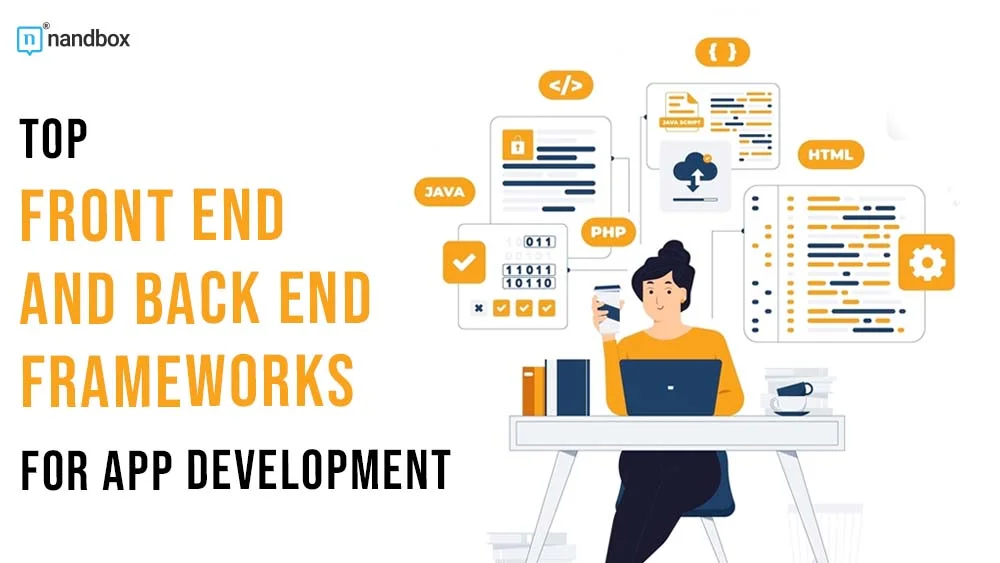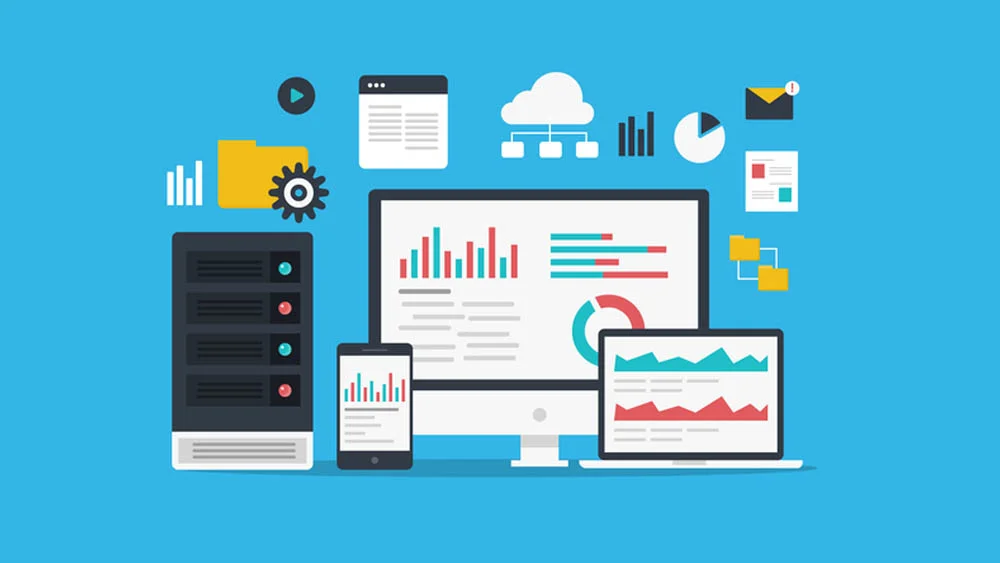Some processes and tasks are very easy, such as taking candy from a little kid. I know this is such an evil deed, but that’s for the sake of the example. Some processes can be less easy, such as driving a bike or downloading an app. However, some processes can be very difficult, such as developing an app. The process of developing an app is a vast and complex one. That is why it takes much time, effort, skills, and so on. Just like any other complex process, the app development process has many parts or stages. However, the most important two of the many stages are front-end and back-end development. The names don’t ring a bell. It is okay; that is what this article is for anyway! In this article, we will discuss the two processes of front-end and back-end development, their importance, and the challenges that face developers. In addition, we will demonstrate the most important front-end and back-end frameworks that developers rely on significantly.
What Is Back-End Development?
Let us start with the back-end development, but first, we will give you a glimpse into the back-end and front-end development and the ideas behind them. Both processes are not limited to app development; they are also an integral part of web development as well. Some say that we can summarize the whole development process into these two concepts. However, this is a complete myth. Back-end and front-end processes are two of many other stages that take place during the app development process, such as planning and analysis. Thus, we can’t only depend on them.
Back-end development is the process of developing the server side of any application. The server side consists of any aspect that the user interacts with. Therefore, it includes creating the application’s structure, codebase, and databases, as well as controlling user input and incoming requests. The backend part is the less apparent one, as all its functions happen internally.
Importance and Challenges of Backend Development
Importance
Data Management
When it comes to data, it’s the job of the backend developers to handle things like storing, retrieving, and manipulating. Using databases, file systems, and third-party APIs correctly and efficiently is essential for this.
Business Logic
Backend developers are responsible for coding an app’s fundamental features and the business logic that drives it. To do this, the application must process data, perform calculations, and adhere to the rules and algorithms that govern its behavior.
Security
Protecting sensitive data and obstructing unauthorized access fall under the purview of backend developers. Authenticating users, encrypting data, and following other security best practices are all crucial for mitigating common threats.
Scalability
The backend of an app must be able to scale as the number of users and the volume of data it processes grow. Developers who work on the back end create and deploy systems that can easily expand to meet rising demand by making use of additional hardware and data storage.
Performance
Application performance is enhanced by backend developers who work to minimize database queries, eliminate glitches, and speed up response times. This makes for a more pleasant experience for the user.
API Development
Creating application programming interfaces (APIs) is an important part of backend development because it lets different parts of an app talk to each other and lets third-party apps work with the app. When developing a mobile app, integrating third-party services, or developing a microservice, APIs are crucial.
Challenges
Integration with Third-Party Services
Integration with third-party APIs and services is essential for many applications, as we mentioned before. However, APIs can vary in their authentication requirements and file formats, making it difficult for backend developers to keep track of everything.
Testing and Quality Assurance
Proper and secure operation of the backend depends on it being subjected to rigorous testing. As an example, unit testing, performance tests, and others need to be conducted. That is because they can help find and fix problems before they become major. The number of these tests might be a challenge to many developers, as they require much time and effort.
Documentation
Usually, throughout every development process, developers need to keep track of and document everything. The importance of maintaining up-to-date documentation for the system’s backend APIs, data structures, and other components is often underestimated. Developers might disregard it many times, as it may become a challenge to keep up with.
Best Back-End Frameworks
Convex
Convex brings full-stack TypeScript to your backend with end-to-end type safety—no extra codegen needed—so your client and server stay in perfect sync. Its realtime, reactive database engine automatically pushes data changes to all subscribed clients, eliminating manual WebSocket or polling logic. The serverless platform auto-scales (with an option to run locally or self-host), and its custom storage layer targets sub-100 ms queries backed by smart caching and automatic invalidation. From zero-config setup to built-in optimistic updates, Convex treats your backend as another layer of your app, letting you ship features faster without wrestling with infrastructure, sync bugs, or type mismatches.
Ruby On Rails
The first framework we are going to discuss is Ruby on Rails. Not only is the name very cool, but the framework has many benefits and great capabilities. Ruby on Rails is a framework that specializes in developing the server side of any application. The reason behind the name Ruby on Rails is that the framework is based on the Ruby programming language. It also uses the MVC architecture pattern as a main component and way of developing applications. What makes Ruby on Rails special and favored by many developers is that it is easy to learn and work with. In addition, it includes a rich set of tools that have everything a developer would need.
Django
Another popular backend framework is Django. Django is on a higher level when it comes to back-end frameworks. That is because it uses the Python programming language. With a rich set of tools and options and a quick development process, Django is the choice of many giant companies and businesses, such as Instagram. Django enables developers to have full control over incoming requests as well as implement one of many database options, such as PostgreSQL, SQLite, MySQL, and Oracle. This way, they could choose and switch to any database system they would like.
Laravel
Now, coming to the modern and advanced side, this is the Laravel framework. Laravel is a very popular choice for many reputable platforms due to its convenience and ease of use. Just like Ruby on Rails, the Laravel framework depends on the MVC app architecture for development. What makes it even better is that it is an open-source tool, which means anyone can use it completely for free. This framework has some of the best security measures that developers can deploy into their apps, such as authentication.
What Is Front-End Development?
Now let us discover the next part of the development process, which is the front end. Unlike back-end development, the front end is more apparent and is what users interact with frequently. The front-end part of applications is anything that you directly interact with, such as buttons, cells, icons, layout, and so on. The front-end development includes creating and deploying all of these elements, as well as designing the layout and establishing the whole interface. This process includes making everything as engaging, intuitive, and accessible as possible.
The Importance and Challenges of Front-End Development
Importance
User Experience
The goal of front-end development is to produce a simple and straightforward user interface. Users’ ability to use, learn from, and have fun with an app or website is directly tied to the quality of its user interface.
Improving First Impressions
When a person visits a website or launches an app, the first thing they see is the front end. It’s important to get the front-end design right because it can influence users’ perceptions of a platform as a whole.
Responsiveness
Developers who work on the front end make sure that sites and apps look good on any size screen. To reach more people and provide an optimal experience for those using mobile devices, tablets, and desktop computers, responsive design is essential in today’s multi-device world.
Accessibility
The regulations in many regions are to make applications accessible to everyone, including those with physical impairments. To make applications more accessible, front-end developers add tools like text-to-speech and shortcuts.
Cross-Platform Compatibility
In order to attract the widest possible audience, websites and applications developed by front-end developers must be compatible with all major devices and operating systems. This includes Android, iOS, and all types of devices.
Brand Identity
Logos, color palettes, and fonts are just a few examples of front-end design and branding elements that play a crucial role in the development process. This is because they make a positive impression on users and establish the brand’s credibility.
Challenges
Responsive Design

It can be difficult to create a design that is responsive to different screen sizes, such as those used by desktop computers, tablets, and smartphones. The front-end developers are responsible for making the interface responsive across all devices by utilizing dynamic layouts.
Internationalization and Localization
When designing and developing applications for a global audience, it is important to take into account a wide range of factors. Such as the number of languages and character sets supported and the variety of cultural norms regarding the presentation of information.
Code Maintainability
As front-end codebases expand, it becomes more difficult to manage and organize the code. To ensure that their code is clean and easy to maintain, front-end developers should use architectural patterns, microservices, and coding standards.
Best Front-End Frameworks
AngularJS
Angular is by far the most popular and used front-end framework in the world. It is an open-source framework that Google created in 2016. But what is the reason behind its popularity? It has a wealth of features in addition to being an open-source tool that anyone can access, such as two-way data binding, which enables the real-time reflection of any modification or addition of elements to the application. It is also an ideal framework if you are going to release the app on multiple platforms due to its great cross-platform capabilities.
ReactJS
React or ReactJS, is another exceptional front-end framework that is trusted by many platforms. The framework is run and maintained by Facebook. What makes ReactJS unique is the ease of use and implementation of elements. The framework also supports component reusability, which makes creating the front end of the application easier and more seamless. It is also very flexible and supports many types of devices, including web and mobile.
Ember.js
The last front-end framework we are going to discuss is Ember.js. Ember.js is an open-source tool where developers can create robust applications easily and effortlessly. The framework relies on the Model-View-ViewModel (MVVM) app architecture pattern, which is widely used in many applications. It includes all the UI components that a developer would need. In addition, it enables the creation of reusable UI components as a way to encourage code reusability. Ember.js also includes comprehensive documentation that explains every single step in detail. This helps make the development process even more uncomplicated.
How Can You Choose the Suitable Front End and Back End Frameworks for Your App
A crucial decision that can have a major impact on your project’s success is picking the correct front-end and back-end frameworks for your app. To make these decisions, you’ll need to take a close look at the needs, goals, and constraints associated with your project. Picking the right front-end framework is the first step. Consider issues like the intuitiveness, responsiveness, and interactivity of the user interface. React, Angular, and Ember.js are popular options, but it’s important to pick a framework that fits your development team’s skills and the scope of your project. Understanding the differences between these frameworks will allow you to make a well-informed choice.
You should think about how to scale, how to manage data, and how to keep things secure on the back end. The Django and Ruby on Rails frameworks are both excellent choices that cater to certain needs and programming languages. The requirements of your project, as well as the advantages and disadvantages of each framework, will all play a role in your decision. Community support, documentation, and third-party integrations are additional crucial considerations to keep in mind because of the potential impact they may have on your development timeline.
To ensure a smooth, fast, and well-tailored app development process, it is essential to select frameworks that are a good fit for your project’s specific requirements. Building successful, scalable software that lives up to users’ expectations begins with making well-informed decisions about the front-end and back-end frameworks.





